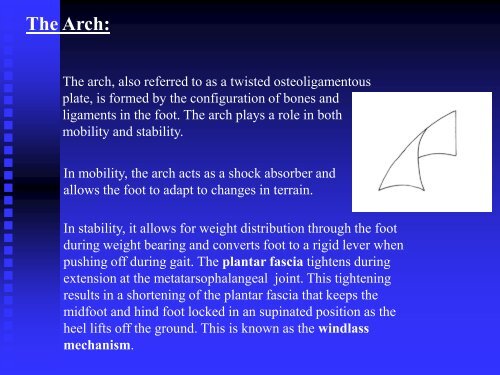Basic Structure and Function of the Ankle and Foot - Home
Basic Structure and Function of the Ankle and Foot - Home
Basic Structure and Function of the Ankle and Foot - Home
Create successful ePaper yourself
Turn your PDF publications into a flip-book with our unique Google optimized e-Paper software.
The Arch:<br />
The arch, also referred to as a twisted osteoligamentous<br />
plate, is formed by <strong>the</strong> configuration <strong>of</strong> bones <strong>and</strong><br />
ligaments in <strong>the</strong> foot. The arch plays a role in both<br />
mobility <strong>and</strong> stability.<br />
In mobility, <strong>the</strong> arch acts as a shock absorber <strong>and</strong><br />
allows <strong>the</strong> foot to adapt to changes in terrain.<br />
In stability, it allows for weight distribution through <strong>the</strong> foot<br />
during weight bearing <strong>and</strong> converts foot to a rigid lever when<br />
pushing <strong>of</strong>f during gait. The plantar fascia tightens during<br />
extension at <strong>the</strong> metatarsophalangeal joint. This tightening<br />
results in a shortening <strong>of</strong> <strong>the</strong> plantar fascia that keeps <strong>the</strong><br />
midfoot <strong>and</strong> hind foot locked in an supinated position as <strong>the</strong><br />
heel lifts <strong>of</strong>f <strong>the</strong> ground. This is known as <strong>the</strong> windlass<br />
mechanism.


